#Sculpture by Gianlorenzo Bernini
Explore tagged Tumblr posts
Text



The Martydrom of Saint Lawrence, Gianlorenzo Bernini, 1617
#saint lawrence#gianlorenzo bernini#bernini#17th century#art history#art#aesthethic#italian art#baroque#sculpture#uffizi gallery
53 notes
·
View notes
Photo

MWW Artwork of the Day (5/10/23) Gianlorenzo Bernini (Italian, 1598-1680) David (c. 1623-24) Carrara marble statue, 170 cm. high Galleria Borghese, Rome
When he tackled his David in 1623-24, Bernini knew that he was risking comparison with works in a sculptural tradition that included the great names of the artistic culture of the Italian Renaissance, from Donatello to Verrocchio and Michelangelo. He subverted the traditional way of representing David. Instead of depicting the static figure after killing Goliath (as had Donatello and Verrocchio) or the measured strain of the act itself (as had Michelangelo), Bernini once again countered with the dynamic charge of the spiral. It is well known that he took his inspiration from the so-called Borghese Gladiator, now in the Louvre but at the time one of the prize pieces in Cardinal Borghese's collection. From the Gladiator derive the feet planted widely apart and the twisting torso.
For more of Bernini's work, see this MWW Special Collection: https://www.facebook.com/media/set/?vanity=TheMuseumWithoutWalls&set=a.371960352909340
20 notes
·
View notes
Text
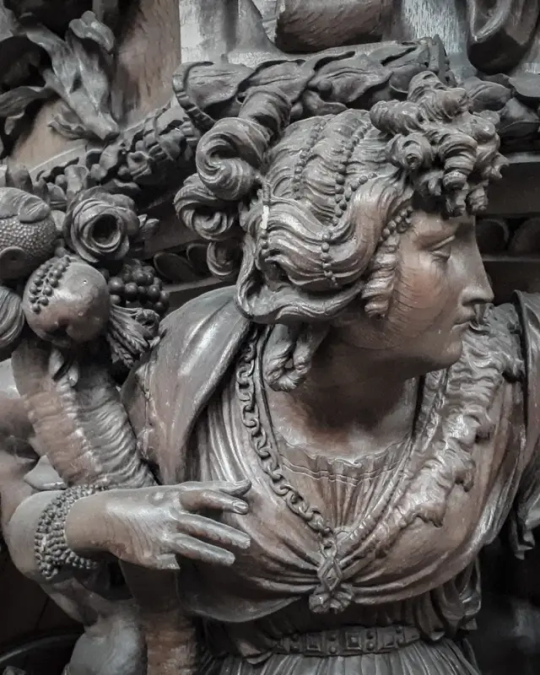
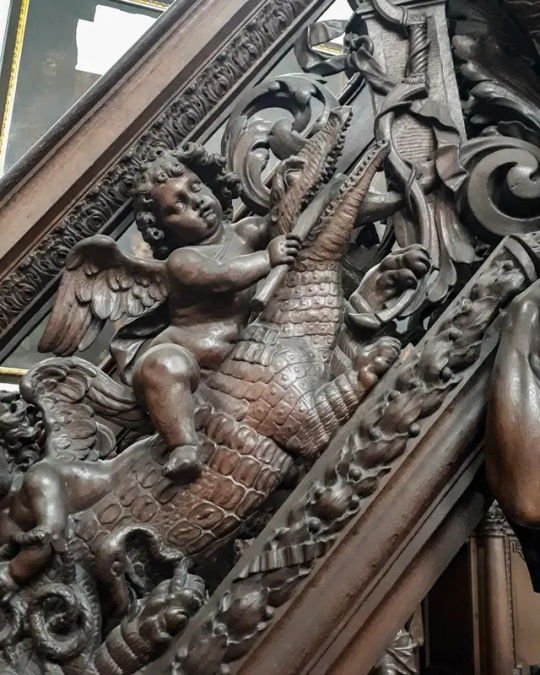

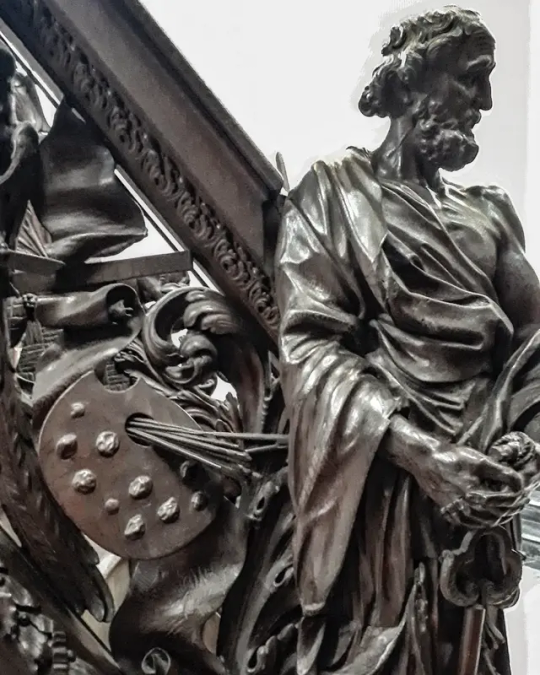
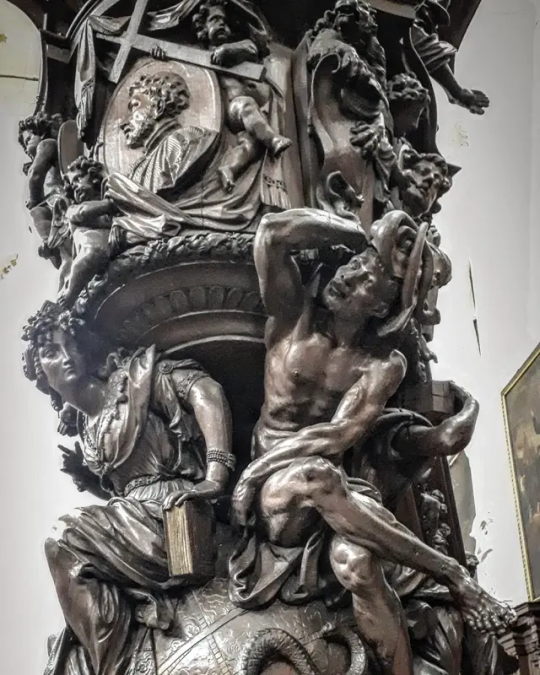




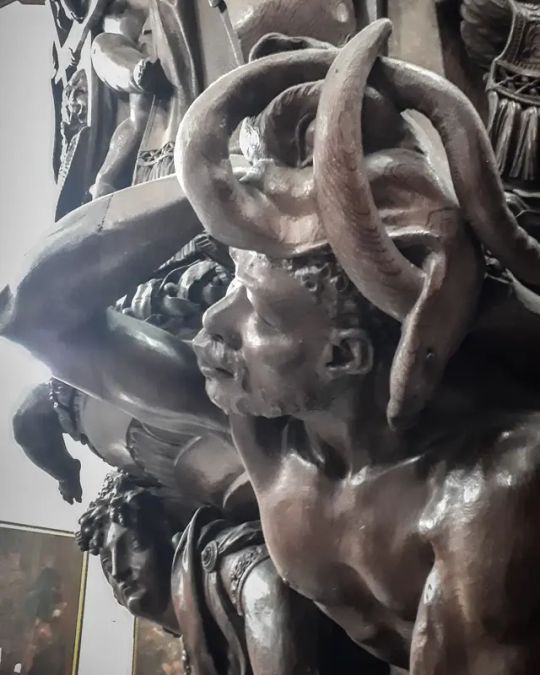
Mechelen was from the late middle ages till the baroque period a centre of woodsculpting. So in this city you can find many top noch furnitures, wood carvings and woodsculptures. Here i present to you the pulpit of the Saint-Peter-and-Paul church (Sint-Pieter-en-Pauluskerk) in Mechelen, Belgium.
The Saint Peter and Paul Church is a former Jesuit church on the Veemarkt in Mechelen. The pulpit, a work by Hendrik Frans Verbruggen (ca. 1700), shows in the form of allegorical figures the spread of the Faith across four continents by the Jesuit Francis Xavier.
The base is a globe resting on crawlers; The globe contains the four then known continents, in the form of persons and characteristic animals:
America: the Indian, turtle and snake
Europa: the young woman with the horn of abundance (cornucopia), a sceptre, a book and a doe
Asia: the woman with a turban and the leopard
Africa: the black one covered with elephant skin, and the crocodile.
Some background on the sculptor Hendrik Frans Verbruggen:
He was born into a family that produced a number of prominent sculptors in the 17th and 18th centuries who were mainly active in Antwerp. His father, the sculptor Pieter Verbruggen, was one of the most important representatives of the Flemish High Baroque in sculpture. The father had been apprenticed to Erasmus Quellinus I, who himself was the founder of a prominent family of sculptors. The father was married to the daughter of his teacher Erasmus Quellinus. From this marriage Hendrik Frans Verbruggen was born. His brother Pieter Verbruggen also became a sculptor and worked in his father's studio.
He was initially trained by his father. However, he is said to have started his career with the book illuminator Jan Ruyselinck. It cannot be ruled out that after his education, like his brother Pieter, he first made a trip to Italy. This journey is not documented. The influence of the Italian sculptor Gianlorenzo Bernini on his work could also be explained by the fact that he used drawings after Bernini's works and antique sculptures that his brother made in Rome as a source of inspiration.
He became a master sculptor with the Antwerp Guild of Saint Luke in 1682. That year he married Susanna Verhulst. He became dean of the Guild of Saint Luke in 1689. In 1713 he went bankrupt, but this did not prevent him from completing existing assignments.
#historical#belgium#history#historical interior#art history#wood sculpture#sculptures#scultura#sculpture#pulpit#wood#oak#fine art#flemish art#flemish#sculptor#churches#church#eglise#iglesia#igreja#chiesa#religious art#mechelen#flanders#brabant#baroque art#baroque#barok#europe
24 notes
·
View notes
Note
knock knock!! your hbo secret santa here and excited to make for you!
you’ve provided a bunch of very good references, and just to get into it more, could you please give me a list of your favorite movies? and then again your favorite pieces of visual art? i’d like to know what makes your eyes happy! ❄️
hey! good to hear from you <3. i'm all over the place atm, but let's seeee
movies
- when harry met sally (1989)



- eternal sunshine of the spotless mind (2004)



- apollo 13 (1995)



- once upon a time in hollywood (2019)



visual art/artists
- ron hicks (paintings)






- gianlorenzo bernini (sculptures)



- dorothea lange (photography)






2 notes
·
View notes
Text
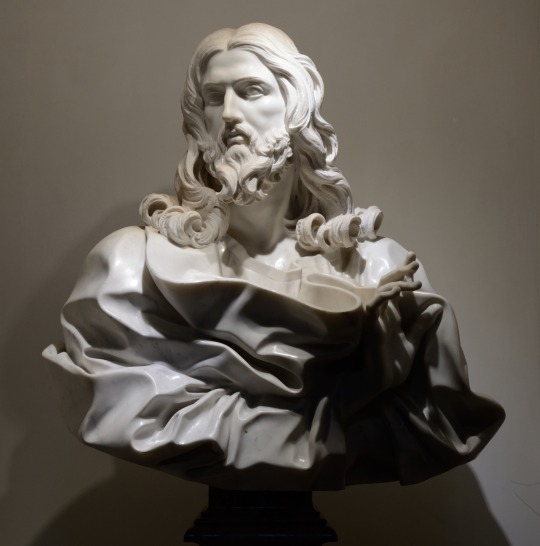
Bust of the Saviour (Salvator Mundi)
(Bust of Jesus Christ)
Sculpture by Gianlorenzo Bernini
marble and jasper, 1680
#Gianlorenzo Bernini#art#artist#sculptor#sculpture#marble and jasper#1680#Sculpture by Gianlorenzo Bernini#Bust of the Saviour (Salvator Mundi)#Bernini
88 notes
·
View notes
Photo


Gianlorenzo Bernini (Napoli, 1598 - 1680)
_
Medusa, c. 1638-48. Marble. Palazzo dei Conservatori, Rome
Born the son of a Tuscan sculptor in Naples in 1598, Bernini was a child prodigy and learned sculpting skills from his father, who worked for the great families in Rome starting in 1605.
Even in his first works, the artist attempted to represent subjects and moods never before attempted, such as portraying the human soul. Here he chose to capture the mood of the monstrous metamorphosis under Athena’s punitive curse, with bald baroque plasticity on the marble, originally patinated and recently restored
https://www.famsf.org/press-room/berninis-medusa
https://en.wikipedia.org/wiki/Medusa_(Bernini)
#Gianlorenzo Bernini#Medusa#sculpture#marble#Baroque#masterpiece#Hair#snake#detail#monsters#head#hi resolution
65 notes
·
View notes
Text

The Ecstasy of Klimt van Zieks
#dgs spoilers#tgaa spoilers#dai gyakuten saiban spoilers#the great ace attorney spoilers#genklimt#genshin asougi#klimt van zieks#klint van zieks#sovriart#yes this is based on the baroque catholic sculpture /the ecstasy of saint teresa/ by gianlorenzo bernini
81 notes
·
View notes
Photo

sculpture by gianlorenzo bernini
10 notes
·
View notes
Text
Ekphrasis in The Danton Case, Thermidor, and their adaptations
Ekphrasis is invoking a piece of visual media into a literary piece. It can be done for a variety of reasons, from entirely pragmatic (mostly grounding the literature in reality - if the invoked piece is a real piece of art, one you could find in a museum, for example) or more poetic (drawing some symbolic meaning between the piece of art and the idea behind the text).
In Przybyszewska's plays ekphrasis is nonexistent, at least on the foreground. I don't recall any clearly established visual, given to the readers by the original author. It's not weird in any way - how many pieces of medai do you recall which refrain from its sophisticated and additional piece of subtext and iformation? Hundreds, probably. The only other artistic thing that she has weaved into her plays is La Marseillaise, which is invoked twice in The Danton Case. There are also three book references to Othello, Orlando furioso and this one book Robespierre summarizes to Saint-Just when he's talking about hatred (but of which I have no idea if it's a real one - it probably is - or not). Other than that - nothing, plus the books count only a little, forekpfrasis should be, as I said, visual in nature.
Of course, the historical aspect of her works is what grounds them in our reality, and so cleverly, too (seeing as they're not really historical plays in any way or form, but manage to fool most anybody). And thanks to her extensive stage directions, we have no need of any additional element helping us visualize the scenes, for she does it perfectly enough on her own.
However, seein as these are plays calls for a mirror ekpfrastic effect and thus theatrical and cinematographical adapations are born. And they, on the other hand, have a potential to be filled to the brim with visual refernces. Here I would like to have a look at a few, which are taken from one of the most well known staging and the famous Wajda movie (plus some). In no particular order, there goes:
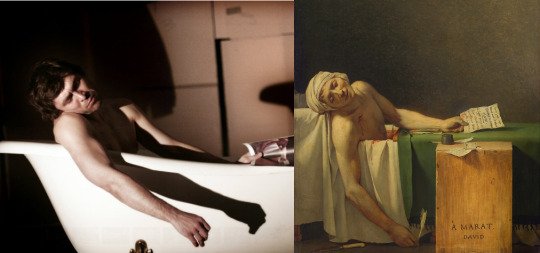
This is the very first scene of a controversial theatre adaptation of The Danton Case. Instead on portraying Robespierre as a firm leader, who only in the very end collapsed temporarily under the huge responsibility he now had to bear, the director decided to portray him as someone physically weak, not in the sense Danton meant when he called him a weakling, but in the sense of somebody who already bears so much responsibility, pain, physical ailments, doubts and whatnot. Just: everything, everythin a human could possible deal with, he deals with, and has to do so in a way that doesn't make people suspiscious about his "shortcomings". There is a interesting parallel between him and Saint-Just, whose upright and unbreakeable character is symbolised by a neck braces, something which people wear after a spine endangering accidents - and incidentally, wasn't it Saint-Just who accused Robespierre of "breaking his spine"? But not in this adaptation, oh no - here their very last scene is cut extremely short and they recite the last few sentences along with some Thermidor lines as two floating heads, a vision into the future which awaits them.
Enough about Saint-Just, though, let's focus on Robespierre and Marat. I must admit I know next to nothing about him, only what some passage here and there in this or that historical study might tell me, but I know, as does everybody, that he was known as L'ami du Peuple, which is why of the reasons, I think, why the director took this image and transposed it onto Robespierre: to make him even more likeable, to show for the umpteenth time that it is Robespierre whom we should cheer on and whom we should feel sorry for. This might also be a parallel between their both's tarnished health, their premature deaths and - last but not least - the role of an icon of the Rvolution both of them play in nowadays' audience's minds. You don't have to study history to knowwho Robespierre was, you don't have to study art to know this painting. Even if you don't agree with some more in-depth explanation of linking this person to this painting, it is a good opening image. It captures our attention in a good way.
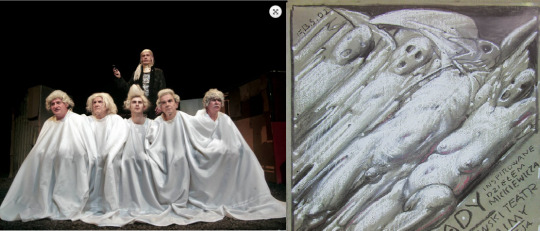
I had mention Saint-Just and there he is, in the background of the picture, symbolically assisting Danton and his clique in their last moments. Instead of shwoign them in torn shirts, the director went into another direction altogether and enshrouded them in white sheets from heads to toes, making them all look like very stereotypical ghosts, whom they will all become in just a couple of moments.
In Polish culture, the first thing that comes to mind when talking about ghosts is Dziady, an old slavic tradition that is now replaced with the Catholic All Souls Eve. Dziady is no longer, apart from perhaps some small minorities who still practice old pagan faiths, but as a ritual, they are immortalised in a play by Adam Mickiewicz, undoubtedly the greatest Polish poet ever. Everybody know this play, some scens - by heart, and they were and are being staged pretty much constantly from one point on. Needless to say, they inspire a lot of art, and I decided to show this very fmous poster by the most famous Polish poster designer, Franciszek Starowieyski…
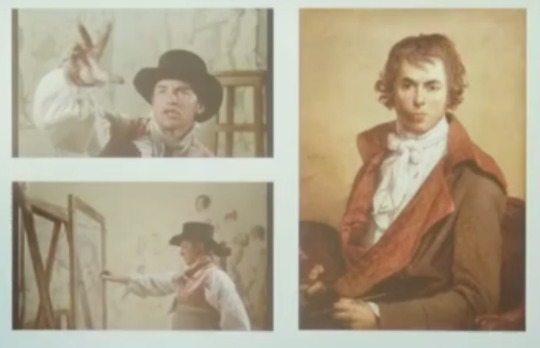
…who is important in this case, because he played David in Wajda's movie.
Not many people know - because his other carreer overshadowed by a lot his first one - that Wajda was a painter. Who actually hated his art, some of his pieces are in the national museum of contemporary art in Łódź alongside stars such as Władysław Strzemiński (the hero of Wajda's very last movie), which is a fact he absolutely detested. I dont know, nor do I care, why was that, because what matters is his previous education as an artist at the very least helped him not only to envision the visuals of the movie, but also acquainted him with great works of art. On which he could model this or that setup. I think it's a nice little detail he catsed Starowieyski as David, a real painter acting as another real painter, it adds a layer of reality onto the movie, and presumably makes for a more natural acting in the few scenes he was in his studio (I also think they look alike).
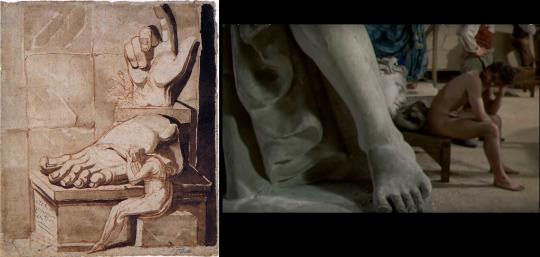
Speaking of David's studio, I once stumbled upon a lecture which drew parallels between some scenes in the movie and some paitings, which was mostly focused on character and costume design, and truth be told didn't contribute much to the overall watching experience of Danton. However, I must admit the lecturer had a very good eye in this one particular case, in which he pointed out that this quick shot in David's studio pretty obviously invokes the Fussli's The Artist's Despair Before The Grandeur Of Ancient Ruins. I don't think it's a coincidence (or at the very least, would be funny if it were) this shot is shown during the scene where Robespierre starts to grasp at desperate measures to save the country/save his own face in the trial. It is an artist's despair, only artist of a different kind. And it is a despair when being faced with a (possible) ruin of something great, even if its greatness is not yet formed, as opposed to the greatness passed.
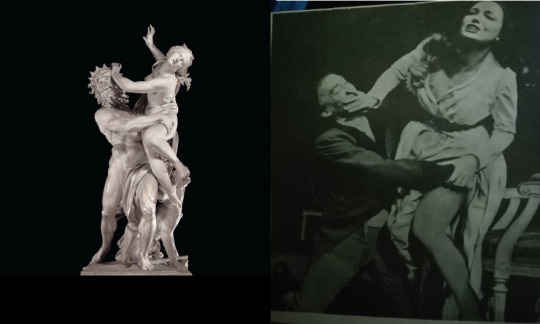
The very last example I was able to think of was this photo I found of The Danton Case from 1975. It is one of those old, very classical (I presume) adaptations, which are mostly filled to the brim with riddiculosly attractive people and very often deliberately drew from other sources of artistry, like the one pictured above. No matter what the real relationship between Louise Danton and her husband was, in the play it is portrayed as something atrocious, and I cringe whenever directors try to make it something else without good reasons for doing so, so I am very glad in the past at least they stuck with classicaly depicted acts of violation against women, not because it is a violation, but because in the classical stories (like the myth of Persephone shown in the sculpture above) the woman will usually get her revenge. Just like Przybyszewska's Louison did.
Thank you for bearing with me until the end, and if you have any other examples of this come to your mind, I compel you to share them with me!
List of pieces of art in the order of their appearance:
Jacques-Louis David, The Death of Marat
Franciszek Starowieyski, Dziady
Jacques-Louis David, Self-portrait
Heinrich Fussli, The Artist's Despair Before The Grandeur Of Ancient Ruins
Gianlorenzo Bernini, The Rape Of Persephone
#Stanisława Przybyszewska#stanislawa przybyszewska#andrzej wajda#the danton case#sprawa dantona#thermidor#jan klata#jerzy krassowski#jacques louis david#heinrich fussli#gianlorenzo bernini#art#ekphrasis#franciszek starowieyski#painting#sculpture#ekfraza#rzeźba#sztuka#Ekphrasis is my current hobby so I had to pull this together
40 notes
·
View notes
Text

Apollo and Daphne by Gianlorenzo Bernini; detail (1622-1625).
Location: Galleria Borghese (Rome)
#italy#photography#rome#art detail#bernini#sculpture#statue#marble#baroque#apollo and daphne#mythology#greek myths#Gianlorenzo bernini#greek myth aesthetic#myths#baroque style#mannerism#art#apollo e Dafne#galleria borghese#1600s art#17 century#1600s#flowers#italian art#italian artist
386 notes
·
View notes
Text
My favorite thing about art history is that everyone who studies it is absolutely enchanted by bernini's the rape of proserpina. Enchanted by that one detail, you know the one.
My teacher showed us simon schama's power of art episode about him, and it was the only time i saw everyone completely immersed in the class.
At the end of that class, the teacher said to me "It's easy to fall in love with bernini", and I've been thinking about that ever since.
#He really was a god among men huh#Why are terrible people amazing artists#Why is he the most extraordinary sculptor to ever walk this earth#Bernini#Gianlorenzo bernini#gian lorenzo bernini#Art history#Sculpture#Baroque
50 notes
·
View notes
Text

MWW Artwork of tthe Day (12/18/24) Gianlorenzo Bernini (Italian, 1598-1680) David (c. 1623-24) Carrara marble statue, 170 cm. high Galleria Borghese, Rome
In comparison to the earlier celebrated David sculptures, Bernini paid particular attention to the biblical text and sought to follow it as closely as possible. Unlike the earlier sculptures, Bernini's hero has a shepherd's pouch around his neck which already contains pebbles ready to use in the deadly sling which he will use against Goliath. The upper part of David's body is represented immediately after has taken a stone from his pouch. This means that the torso twists and strains not just physically but psychologically. The hero is depicted when, having taken the stone from his pouch, he twists his body in the opposite direction, tensioning it spring-like, then stops to think for a spilt second before releasing the stone that will slay Goliath.
7 notes
·
View notes
Text
When stone came to life.
Gianlorenzo Bernini
82 notes
·
View notes
Text

______Apolo and Daphne (1622-25) by Gianlorenzo Bernini. *
74 notes
·
View notes
Text

Gianlorenzo Bernini, Saint Sebastian, 1615
3 notes
·
View notes
Photo

David Sculpture by Gianlorenzo Bernini 1623-24 Marble pre-restoration Galleria Borghese, Rome
#Gianlorenzo Bernini#Bernini#art#artist#sculptor#Sculpture by Gianlorenzo Bernini#David#1623-24#Marble#Baroque#pre-restoration#Galleria Borghese Rome#sculpture
63 notes
·
View notes